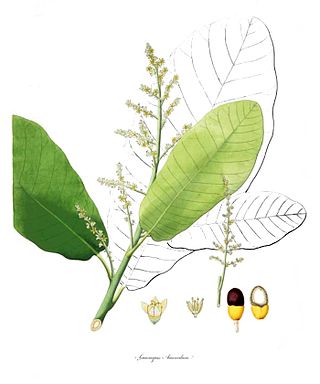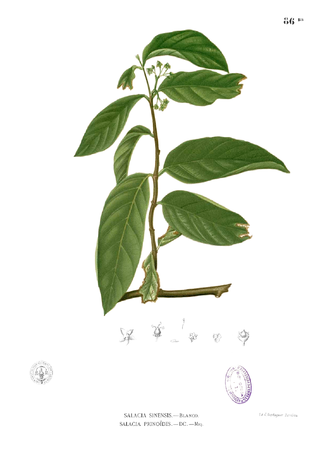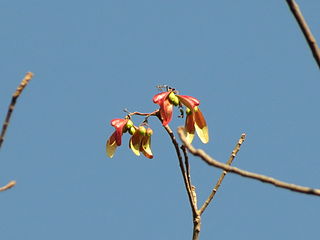
Shorea is a genus of about 196 species of mainly rainforest trees in the family Dipterocarpaceae. The genus is named after Sir John Shore, the governor-general of the British East India Company, 1793–1798. The timber of trees of the genus is sold under the common names lauan, luan, lawaan, meranti, seraya, balau, bangkirai, and Philippine mahogany.

Hedychium is a genus of flowering plants in the ginger family Zingiberaceae, native to lightly wooded habitats in Asia. There are approximately 70-80 known species, native to India, Southeast Asia, and Madagascar. Some species have become widely naturalized in other lands, and considered invasive in some places.

Pterospermum is a genus of flowering plants in the mallow family Malvaceae. Its species are tropical trees that range from southern China across tropical Asia.

Dennstaedtia is a mostly tropical and subtropical genus of ferns described as a genus in 1801. Hayscented fern, or Cup ferns, are common names for some species in this genus. Its best-known member is probably the temperate North-American hay-scented fern, Dennstaedtia punctilobula, which forms extensive clonal ground-cover colonies on level surfaces in the Appalachian area.

Hopea is a genus of plants in the family Dipterocarpaceae. The genus was named after John Hope, 1725–1786, the first Regius Keeper of the Royal Botanic Garden, Edinburgh. It contains some 113 species, distributed from Sri Lanka and southern India to southern China, and southward throughout Malesia to New Guinea. They are mainly main and subcanopy trees of lowland rainforest, but some species can become also emergent trees, such as Hopea nutans.
Parashorea lucida is a species of plant in the family Dipterocarpaceae. The name lucida is derived from Latin and refers to the venation on the leaf. It is a tall emergent tree, up to 60 m tall, found in mixed dipterocarp forest on clay and clay soils. It is found in Sumatra and Borneo. It is threatened by habitat loss.

Parashorea macrophylla is a species of plant in the family Dipterocarpaceae. The name macrophylla is derived from Greek and refers to the species extremely large leaves. It is endemic to Borneo, being found in Brunei, Sarawak and West Kalimantan. The timber is sold under the trade name of white lauan or white seraya. It occurs in protected areas in Sarawak but elsewhere it is threatened by habitat loss.

Parashorea malaanonan is a species of plant in the family Dipterocarpaceae. it is found in the Philippines and the northeast coast of Sabah in Borneo. The name malaanonan is derived from Tagalog and is a putative vernacular name for this species. It is a large emergent tree, up to 60 m, found in mixed dipterocarp forests on deep friable clay soils. It can still be found in forest reserves in the east coast of Sabah although elsewhere it is threatened by habitat loss. The timber is a light hardwood sold under the trade name of white lauan or white seraya.

Semecarpus is a genus of plants in the family Anacardiaceae.

Tectaria is a genus of fern in the family Tectariaceae, according to the Pteridophyte Phylogeny Group classification of 2016. Halberd fern is a common name for species in this genus.

Vatica is a genus of plants in the family Dipterocarpaceae.

Dracontomelon is a genus of flowering plants in the family Anacardiaceae, growing mostly in SE Asia and the Pacific islands. The fruit may be used in local cuisine, especially as souring agents.

Anisoptera is a genus of plants in the family Dipterocarpaceae. The name Anisoptera is derived from Greek and describes the unequal fruit calyx lobes. It contains ten species distributed from Chittagong (Bangladesh) to New Guinea. Eight out of the ten species are currently listed on the IUCN redlist. Of these, four species are listed as critically endangered and the other four as endangered. The main threat is habitat loss. The timber is a light hardwood.
Parashorea tomentella is a species of plant in the family Dipterocarpaceae. It is endemic to eastern Borneo. It is a large emergent tree, up to 65 m tall, found in lowland dipterocarp forests on fertile clay soils. It is a light hardwood sold under the trade names of White Lauan or White Seraya. It is found in forest reserves on the east coast of Sabah.
Parashorea smythiesii is a species of plant in the family Dipterocarpaceae. It is endemic to Borneo. It is a large emergent tree, up to 55 m tall, found in mixed and upper dipterocarp forests on fertile clay soils. It is found in some protected areas.
Parashorea parvifolia is a species of plant in the family Dipterocarpaceae. The name parvifolia is derived from Latin and refers to species small leaves. It is endemic to Borneo. It is a large emergent tree, up to 60 m tall, found in mixed dipterocarp forests on fertile clay soils. It is present in protected areas, including Lambir Hills National Park.

Salacia is a genus of plants in the family Celastraceae. They are woody climbers naturally found in tropical regions.

Helicteres is a genus of flowering plants in the family Malvaceae. Its range is from tropical and sub-tropical Asia through to northern Australia, and also Mexico through to the northern half of South America.

Pterocymbium is a genus in the family Malvaceae: in the subfamily Sterculioideae and previously placed in the Sterculiaceae. In Indonesia, P. tinctorium (Kelumbuk) is a significant timber tree.

Loeseneriella is a genus of flowering plants belonging to the family Celastraceae.
















